See all > Skin and hair care
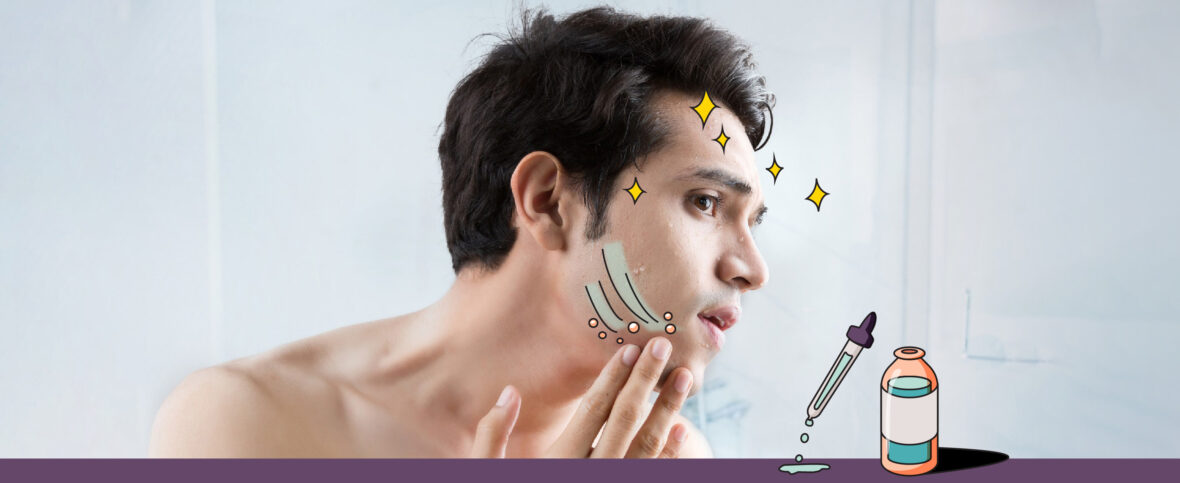
What is cystic acne?
There are few types of acne more aggravating than cystic acne. These types of pimples are buried beneath your skin, beyond the reach of squeezing fingertips. They can hurt as they develop, eventually crowning with a large, noticeable dome. So what is cystic acne, and how can you get rid of it?
Cystic acne is a type of acne where painful cysts form under your skin. It emerges when dead skin cells, oil, and bacteria get trapped in your pores. That leads to infection under the skin’s surface. The infection weakens the walls between your skin’s cells, creating large fluid sacs that are commonly known as cysts. The cysts fill with pus as your body works to fight the infection off. The result is red, inflamed bumps on top of your skin that are itchy and painful. If they pop, the bacteria spreads. This leads to the creation of more pimples, and the cycle continues causing widespread cystic acne.
Anyone can get cystic acne, but it mostly affects teenage boys and men in young adulthood. In men it appears on the face, neck, upper arms, chest, and back. Women more commonly have breakouts on the lower half of their face.
How does cystic acne develop?
Hormones play a role in the development of cystic acne. A particular group of hormones called androgens are responsible for increasing your skin’s oil production. Testosterone is an androgen, and when it increases quickly it activates your oil production glands. That leads to oily skin—a key component in the development of cystic acne. That’s why it’s more common in teenagers, or women who are menstruating, pregnant, or menopausal. All of those phases come with significant hormone shifts.
There are lots of myths about cystic acne out there. Contrary to popular belief, diet doesn’t cause cystic acne breakouts. Eating greasy foods or chocolate doesn’t necessarily make acne worse. Another common misconception is that people with acne don’t practice proper hygiene. Cystic acne is tough to get rid of, and simple soap and water usually aren’t strong enough to make it go away.
How do I know if I have cystic acne?
Cystic pimples are one of many pimple types. Here’s a breakdown to help you identify them:
Blackheads
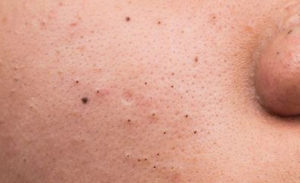
Blackheads form when hair follicles get clogged with dead skin cells or sebum, which is the oil your skin naturally produces. When the follicle is plugged it forms a bump called an open comedo. Because the comedo is open, the contents are exposed to air and they oxidize. That’s what makes the top of the opening appear black. Other than by colour, you know a blemish is a blackhead when it isn’t filled with any pus.
Whiteheads
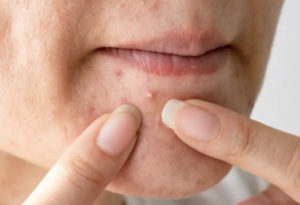
Whiteheads happen when your pores get clogged with dry skin cells, oil, and bacteria. With whiteheads, the opening to the pore remains closed with the debris trapped inside. Whiteheads tend to happen when your body is going through hormonal changes. They’re common on the face, back, chest, and shoulders.
Papules
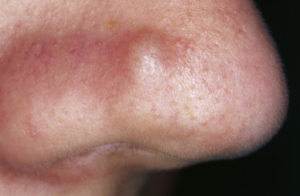
A papule is a small, raised, red bump. Its key feature is that it isn’t filled with any type of pus. Papules usually turn to pustules over time as a pimple develops.
Pustules
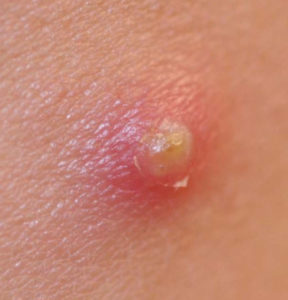
Pustules are bumps that appear on the skin and are filled with pus or fluid. They usually start as papules. They’re a lot bigger than whiteheads or blackheads and are most often found on the face, neck, back and chest.
Nodes
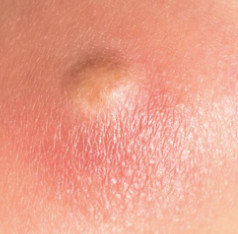
Nodes, or nodular acne, is a form of pimple that occurs in deeper layers of the skin. The nodes are hard bumps. They’re painful to touch and can last a long time. Sometimes they don’t form an opening like other pimples do. They’re hard to get rid of on your own, so it’s good to have a dermatologist drain nodes to avoid scarring.
Cysts
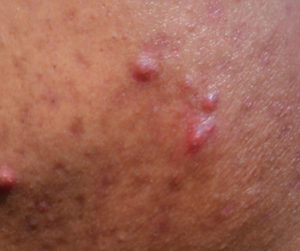
Cysts are the most severe form of blemish. They’re large, soft, and painful red bumps on the skin. Like nodes, the infection that leads to cysts is deep under the skin’s surface. If you think your acne might be cystic, don’t pick at the cysts. It can lead to further infection and long-lasting acne scars.
Cystic acne and scarring
Because cystic acne happens deep under the skin, it can lead to scarring. Infection breaks the cellular wall between pores. This destroys the skin’s tissue, leading to scars. Plus, when the skin breaks the infected pus inside can spill over into other healthy skin cells. This causes the infection to spread, resulting in more small pockets of scarring.
There are two types of scars you can develop from cystic acne:
- Keloid scarring — this happens when your body produces collagen while attempting to heal your skin. Sometimes the body produces too much collagen, leaving bumps. Keloid scars are raised, and a lot of the time they’re bigger than the area that was originally damaged.
- Depressed scarring — this is a type of scar that looks like clusters of little indents in the skin. They’re sometimes referred to as icepick scars.
In less severe breakouts like whiteheads or blackheads, the infection in the skin is shallow. That makes for less cellular damage. Your skin usually returns to normal after these minor breakouts.
Getting rid of cystic acne
Cystic acne lives deep under the skin, so getting rid of it completely without a prescription is unlikely. Picking at cysts can lead to scarring and the spread of infection. If you want to take a targeted approach to getting rid of cystic acne, speak to a dermatologist. They may recommend treatments like oral antibiotics to control swelling, or birth control to rebalance hormones.
There are ingredients you can find in over-the-counter medication to make your skin less oily, which will help slow acne spread. Some of them include:
- Salicylic acid, which helps your skin break up dead skin cells so they fall off instead of becoming trapped in your pores.
- Benzoyl peroxide, which reduces the amount of bacteria on your skin and helps your skin shed dead cells.
- Retinoids are antioxidants, which are rich in vitamin A. They remove debris from your pores and create conditions that promote healthy cell growth.
Cystic acne is challenging to get rid of, but the good news is that it’s possible to improve your skin’s condition. There’s a wide range of treatment options, from oral medication to procedures like draining those painful bumps. If you want to speak to a dermatologist to show cystic acne who’s boss, you can speak to one online in under 24 hours.
The information presented here is for educational purposes and is not meant to replace the advice from your medical professional.
When using virtual care, all medical treatment is at the sole discretion of the provider. Virtual care is not meant for medical emergencies, and your provider will determine if your case is appropriate for virtual care. If you are experiencing an emergency like chest pain or difficulties breathing, for example, please call 911 or go to your nearest emergency room.
Trusted by millions of Canadians
Get started now

We're trusted by millions of Canadians
Join millions of Canadian families who enjoy 24/7 access to medical care within minutes.
Get started now4.7 score
8K+ Trustpilot reviews
Do you need medical care today?
Trusted, experienced doctors and nurse practitioners are ready to see you.
